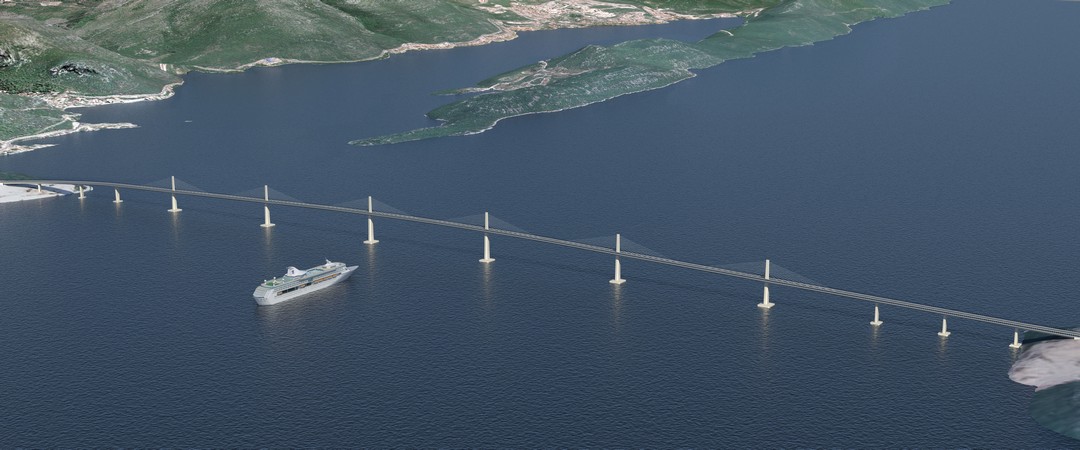ISSN 2232-9080
No. 16, December 2018.

DESIGN AND ANALYSIS OF THE PELJEŠAC BRIDGE
Marjan Pipenbaher
Ponting – Pipenbaher Consulting Engineers, Manager and Head Designer
Abstract: The 2,404 m long Pelješac Bridge ranks among the most demanding bridges in the world, not only in terms of complexity of construction, but also in terms of complexity of design. It is located in the area of high seismic activity, with the peak design acceleration of soil at the bedrock level PGA=0.34g, and the required design acceleration of 0.54 g. The compact bedrock is located at a depth of up to 80 m below the sea bed, which requires extremely deep foundations on driven steel piles, up to 124 m long. The bridge is located in the area of strong and gusty winds with the reference wind speed exceeding 34 m/s. Particular attention was paid to ensuring that the bridge remains stable under strong wind gusts and open for traffic in all weather conditions. ln order to meet the main criteria of quality design, such as stability, durability, economy and integration into the environment, the inventive design proposed the construction of an extradosed bridge with an integrated hybrid structure comprising 5 central spans, each 285 m long, and 6 low pylons. Thus, the designed structure ensures the necessary seismic stability of the bridge without installation of large bearings and additional seismic dampers, which is confirmed by numerous complex non-linear computational analyses, presented in detail in the paper. The soil-structure interaction was considered in all non-linear analyses. After completion the Pelješac Bridge will be ranked among the 5 largest and most attractive European bridges, constructed at the beginning of the 21st century.
Key words: extradosed bridge, stay-cable, deep foundation, piles, earthquake, wind, monitoring
ARCHITECTURAL 3C: COMMUNICATION, CONTINUITY, CONTEXT
Academician Nikola Bašić, architect
Abstract: Defining architecture seems to be a tough and often futile business. Nevertheless, we must not give up on its persistent explanation and new understanding. Today, when architecture has moved heavily into media space, and then also promoted itself to an authentic communication medium, talking about architecture is just as important as talking through architecture. On this occasion, we open a conversation about architecture through the discourse of Croatian national culture, its history, its present, and its future. We wonder whether this small but distinctive culture, whose key components are precisely the inherited urban and architectural values, and, above all, the fascinating landscape culture, can, first, successfully overcome the abyss of discontinuity, and then also resist the osmotic pressure of globalism and cultural imperialism. How to struggle for cultural as well as for architectural identity in the time of a communication revolution that has produced planetary space-time convergence, or, as it is said, the “compression of the World,” and the illusion of its daily “shrinkage.” This reflection seeks to find an answer to the question whether there is any sense in resisting the inevitable civilizational convergence and identification? Can we, and may we, despite everything, unyieldingly persist on our own cultural identity, especially the one that architecture could, or should, carry and promote?
Key words: architecture, architectural language, communication, continuity, context, cultural identity
INFLUENCE OF WATERCOURSE FLOW ON BRIDGE SAFETY
Neven Kuspilić, Ph.D.
University of Zagreb, Faculty of Civil Engineering
Gordon Gilja, Ph.D. University of Zagreb, Faculty of Civil Engineering
Abstract: Indirect action of flow poses a risk to bridge safety as it results in scouring of structural elements, i.e. it changes the geometry of the initial design state and thereby subjects it to new loading conditions. Periodic inspections of riverbed and bridge structure under water establish the actual bridge condition and associated rating, recommendations for monitoring, maintenance and/or repair measures and time to next inspection. Estimation of scouring hazard for a particular bridge and riverbed stability assessment are based on morphodynamic analysis of the erosive capacity of flow on the bridge profile and adjacent watercourse section. This paper presents the results of specialist hydrographic surveys, morphodynamic analysis of the stability of riverbed and protection structures, and underwater visual inspections of structural bridge elements conducted by the Faculty of Civil Engineering Zagreb. For riverbed condition category ratings “good” and “poor”, examples from Croatia where for a particular category characteristic damage is established involving the need for maintenance or repair are singled out.
Key words: Erosion, morphodynamic analysis, bridge, scour, underwater inspection, ADCP
PERFORMANCE BASED SEISMIC ENGINEERING APPLIED TO THE LIGHT FRAME TIMBER WALLS (LFTWS) SHEATHED WITH OSB AND GB
Ljupko Perić
Institut für Baustatik und Konstruktionen
Eidgenoschische Technische Hochschule Zürich
(c.o. MWV Bauingenieure AG,CH-5400 Baden)
Abstract: The most commonly used force based seismic design in the engineering practice has major drawbacks, the practicians are usually not aware of. Thus, the structures have an unknown and unreliable safety coefficient in terms of both human lives and properties. In this paper the application of the performance based seismic engineering to the LFTWs has been presented. The parameter needed for the estimation of the damage index as well as the performance limits for different performance objectives have been proposedfor life safety limit state, characterized by the probability of exceedence of 10% in 50 years and return period RP 475 years.
Key words: Light Frame Timber Walls, LFTWs, OSB and GB sheathing panels, performance based seismic engineering, damage index, Stewart hysteresis, MCASHEW
LABORATORY INVESTIGATION OF EMBANKMENT SETTLEMENT CAUSED BY MARL GRAINS DETERIORATION
Predrag Miščević, Ph. D.
University of Split, FCEAG
Goran Vlastelica, Ph. D.
University of Split, FCEAG
Mijo Nikolić, Ph. D.
University of Split, FCEAG
Abstract: Embankments made of crushed soft rock grains can be susceptible to additional settlement caused by deterioration of the grains inside the embankment. This additional settlement is not caused by the change of the stress state inside embankment and cannot be predicted by standard calculating methods with the embankment modulus of deformability measured after compaction of the embankment. The deterioration of the grains is mainly caused by the weathering process which is, in soft rocks such as marl, mainly induced by the wetting and drying processes. If marl grains in an embankment are subjected to the wetting and drying process, the result is breakage of the grains, as well as decomposition into soil material. Disintegrated material then fills the macropores of the embankment grain structure and gradually causes additional settlement. The samples were made of crushed marl in laboratory conditions. A test was conducted with modified oedometer apparatus. Measured values can be used for estimating the additional settlement caused by the weathering.
Key words: Soft rock; Weathering; Marl; Settlement; Embankment
SLOPE PROTECTION ON WF MESIHOVINA ACCESS ROAD
Maja Prskalo, Ph. D.
University of Mostar, Faculty of civil engineering
Niko Tomić, M. CE.
University of Mostar, Faculty of civil engineering
Abstract: In the paper, calculation of stability and protection of slopes on a section of the WF Mesihovina access road was performed. The calculation was carried out in the software Geostudio (Geo-Slope International Ltd. Calgary, Canada) with adoption of the Spencer method. After the calculation, the type of protection that is used for protection of slopes from local effects was adopted.
Key words: slope stability, type of protection, cuts
STABILITY OF REINFORCED CONCRETE WALLS UNDER SEISMIC LOAD
Mladen Kožul, Ph. D.
Faculty of Civil Engineering, University of Mostar
Ante Džolan, M. CE.
Faculty of Civil Engineering, University of Mostar
Abstract: The damage to reinforced concrete walls, observed after the earthquakes in Chile (2010) and New Zealand (2011), shows that the walls did not achieve the expected ductile behavior and could fail due to local and global instability. Therefore, extensive experimental and numerical research is presently conducted in this direction in order to define the failure mechanism of reinforced concrete walls, especially in relation to their possible buckling. This paper describes one existing mechanism of lateral buckling of walls. Since lateral buckling of reinforced concrete walls is affected by a large number of parameters, it is necessary to continue with the research of this complex phenomenon.
Key words: reinforced concrete walls, ductility, lateral buckling
ANALYSIS OF GROUNDWATER FLOWS IN THE AREA OF THE DESIGNED PSPP VRILO LOWER BALANCING RESERVOIR
Mirna Raič, Ph. D.
Faculty of Civil Engineering, University of Mostar
Anja Palac, M. CE.
Faculty of Civil Engineering, University of Mostar
Abstract: This paper gives an overview of the research conducted as part of the graduation thesis titled: "The hydraulic study of groundwater flows in the area of the lower PSPP Vrilo balancing reservoir", which was developed and successfully defended at the Faculty of Civil Engineering University of Mostar in 2018. The task was to develop a spatial model of steady groundwater flows in the area of the designed lower balancing reservoir of the Vrilo pumped-storage power plant, based on field investigation data and data from the PSPP Vrilo preliminary design.
Key words: lower balancing reservoir, Vrilo pumped-storage power plant, groundwater flow, DHI WASY FEFLOW 7.0, numerical model
FIBER REINFORCED SHOTCRETE - THE BENEFITS OF THE APPLICATION IN TUNNEL BUILDING
Assoc. Prof. Mato Uljarević,Ph. D. CE. ing.
University of Banja Luka, Faculty of Architecture, Civil Engineering and Geodesy, Bulevar Vojvode Stepe Stepanovića 77, Banja luka, professor
Davora Tomić, B. Sc. CE. ing.
University of Banja Luka, Faculty of Architecture, Civil Engineering and Geodesy, Bulevar Vojvode Stepe Stepanovića 77, Banja luka,MA student
Abstract: Fibers enhance the psysical and mechanical properties of concrete and bring wider application of such composite in real projects. The technological development of equipment for the installation of concrete by spraying enabled the use of micro-reinforced concrete, primarily in constructive systems for ensuring the excavation of underground structures. The paper will present the results of testing physical and mechanical properties of concrete mixtures with steel fibers. Тhe adventages of using such a composite on lining of underground structures will be specified. Recommendations for making and installation of micro-reinforced concrete with spraying technology, as well as the approach to dimensioning the tunnel lining made of micro-reinforced concrete will be presented.
Key words: fiber, concrete, physical-mechanical properties, spraying technologie
EXPERIMENTAL TESTING OF SCALED MODEL AND ARCH SEGMENTS OF THE OLD BRIDGE IN MOSTAR
Mladen Kustura, Ph. D.
University of Mostar, Faculty of Civil Engineering
Lidija Krstevska, Ph. D.
Sts. Cyril and Methodius University, Skopje
Institute of Earthquake Engineering and Engineering Seismology – IZIIS
Dragan Ćubela, Ph. D.
University of Mostar, Faculty of Civil Engineering
Abstract: Due to their characteristic appearance and complexity of materials used for their construction, masonry arch bridges are still the subject of experimental and numerical analyses. One of the characteristic examples of this type of structures is the Old Bridge in Mostar that, along with the bridge location, has been under UNESCO protection since 2005. It is exactly this symbol of the town residing on the Neretva River that has been selected as the basis for analysis of behavior of masonry arch bridges and their structural elements. This paper will present the results of the quasi-static tests on connection elements carried out on models of arch segments of the Old Bridge at the scale of 1: 3 as well as the results of the shaking table tests of the behavior of the physical model of the Old Bridge scaled to 1:9 under different levels of seismic excitation. The models were built by application of real connection elements between stone elements – cramps, dowels and liquid lead. Definition of bearing capacity and mode of deterioration of the connection elements of the tested segments as well as definition of the failure mechanisms of the bridge model are the main tasks of the performed experimental investigations.
Key words: masonry arch bridges, static load, seismic load, connection elements, bearing capacity, development of cracks, failure mechanism






